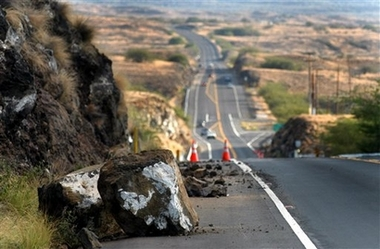KAILUA-KONA, Hawaii - A favorite pidgin expression in Hawaii - "Lucky you
live Hawaii"- gained new meaning Monday as authorities quickly restored
electricity and started to clear away boulders after the strongest earthquake to
hit the islands in more than two decades.

Rocks are shown on a road in Big
Island, Hawaii, after an earthquake, Sunday, Oct. 15, 2006.
[AP] |
Twenty-four hours after Sunday's 6.7-magnitude quake, there were no reports
of any deaths or serious injuries, and there were few signs of any major damage
from the quake or several aftershocks, including one measuring 6.0.
"It lets you know Mother Nature is doing her thing," said Robin Eising, a
teacher at Waikoloa Elementary School, which was closed for the day for
inspection. "It was a wake-up call."
Still, officials cautioned that they needed to inspect the many bridges,
roads, earthen dams, schools and other structures across the Big Island, the
isle closest to the epicenter.
Ray Lovell, state Civil Defense spokesman, said a loss estimate was not
immediately available because damage was so scattered. "It's just premature to
come up with dollar estimates right now," he said.
The Federal Emergency Management Agency was flying a 100-member response team
to Honolulu on Monday with plans to go to the Big Island on Tuesday.
Bob Fenton, FEMA's director of response for the region, said officials were
hearing of "light to moderate" damage to infrastructure.
Utilities restored power to 97 percent of the state's customers by early
morning. That figure was expected to reach nearly all by the end of the day.
Most of Oahu, the most populous island, with more than 800,000 of Hawaii's 1.2
million residents, had been blacked out on Sunday.
Honolulu residents, however, were urged to continue conserving water while
supplies were still being replenished.
The quake hit at 7:07 a.m., 10 miles north-northwest of Kailua-Kona, on the
west coast of the Big Island. On Monday, the U.S. Geological Survey raised its
measurement of the magnitude to 6.7 from a preliminary 6.6.
At least one stretch of road leading to a bridge near the epicenter
collapsed, Civil Defense Agency spokesman Dave Curtis said. Several other roads
on the Big Island were closed by mudslides, debris and boulders, but most were
still passable, he said.
At the 94-bed Kona Community Hospital - the only hospital within 100 miles,
crews were cleaning up. Thirty long-term care patients were taken to a hotel,
and six were airlifted across the island to another hospital.
Donald Lewis, president and chief executive, said the hospital was operating
at about 10 percent Monday. No patients or staff were injured.
"God was on our side," Lewis said. "It's not as bad as it could've been."
Many Hawaii residents breathed a similar sigh of relief. On the Big Island,
people were already returning to work and their lives, as bicyclists training
for Saturday's Ironman World Championship zipped along the highway.
"If you're going to have an earthquake, you couldn't have had it at a better
time, early in the morning when people aren't even out of their homes yet,"
Curtis said. "I think people, under the circumstances, have remained very calm."
John P. Lockwood, a former USGS volcanologist who is now a private
consultant, said another blessing was that the quake did not divert lava flows
from Kilauea Volcano to populated areas. The lava flows safely into the sea.
Even so, "this brings to forefront the need for people to have 72 hours'
worth of supplies to keep them going" after a quake, said Kim Walz, a
spokeswoman with the Federal Emergency Management Agency.
On Monday morning, the Honolulu airport was filled with passengers still
waiting for a flight out.
Silas Garrett, a 52-year-old truck driver from Memphis, Tenn., had been there
since 8 a.m. the previous morning. He said he and his five sisters slept on the
floor using beach towels as blankets and handbags as pillows.
"Every pound we gained on the cruise ship, we lost in the airport," Garrett
said. "The quake shook it off."
But other tourists continued to arrive by the planeload, and some who
experienced the quake saw no need to cut short vacations.
"As long as the airports are open, we're OK," said Dave Kenny of Ortonville,
Mich., who was with his wife and another couple at Volcanoes National Park when
Sunday's quake struck.
"We figured it was a show that Hawaii put on just for us," Kenny said.
State officials also moved to dispel ideas that Hawaii-bound tourists should
change plans.
"We are open for business," Gov. Linda Lingle said.